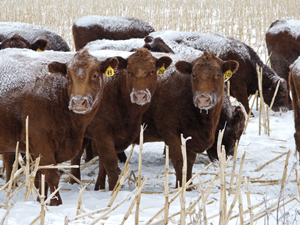5 Tips for Grazing Corn This Fall and Winter
Remarque : cette page web n’est actuellement disponible qu’en anglais.

Corn grazing is becoming more popular across Canada because producers can grow more biomass on less land. If you are planning on grazing corn this winter, here are 5 tips to help you make the most of the corn grazing season:
Ease cattle into grazing corn
If this is the first time you are grazing corn, it may take some time for cattle to realize what they are supposed to do with the tall stalks. It is a good idea to slowly transition cattle from summer pasture to fall corn grazing. Regardless of how familiar they are with grazing, the rumen also takes some time to adapt to the new feed source. One way to do this is to provide access to only a couple days’ worth of feed and also supply cattle with an alternative feed source such as a bale of hay to help them through the transition period.
Limit cows to 3-4 days of feed
Inevitably when cattle are turned out, they will eat the best (more palatable) parts of the plant first, which is the cob. If cows are allowed access too much corn there can be problems with rumen acidosis. Research conducted at the Western Beef Development Centre suggests limiting cattle to 3-4 days’ worth of feed and providing a fibre source (low quality hay or straw) to help mitigate the risk of acidosis.
Protect cattle from the elements
Cattle can graze through the winter as long as they have access to water or loose snow and shelter. If you don’t have a natural tree line or shelter belt on your winter grazing pasture, it is important to provide cattle with a man-made wind break. Energy needs increase as winter temperatures drop. Every degree Fahrenheit below cows’ lower critical temperature increases their energy requirements (TDN) by 1%, so animals may need to be supplemented or will eat more and therefore consume the 3-4 days’ of feed you’ve limited them to more quickly as temperatures drop below their lower critical temperature.
Cattle’s lower critical temperature (LCT) is the temperature at which the maintenance requirements of the animal increase to the point that their performance is negatively affected. LCT varies due to a variety of things; for example a cow maintained at a body condition score (BCS) of 3.0 and has a dry winter hair coat has a lower LCT than thin or wet cows with summer hair coats. Thin cows (BCS of 1.0 – 2.0) typically have a LCT of approximately -17oC, whereas cows in ideal condition (BCS of 3.0) have a LCT of approximately -25oC.
Feed test, feed test, feed test
In most cases corn is able to exceed the nutrient requirements of cattle in the first two trimesters of pregnancy, but it is still important to feed test to determine if the cows’ requirements will be met by grazing corn alone or if additional supplementation (protein) should be provided. Testing corn for mycotoxins is also recommended. Since corn is grazed standing, it is recommended to do a feed and mycotoxin test a couple weeks before grazing so that it is a close representation of what the cattle will actually be grazing. Visit the Feed Testing and Analysis for Beef Cattle page.
Have a plan B
Even with the best plans in place weather conditions such as too much snow, lack of frost, or even too much rain can put an end to corn grazing. Make sure you have an alternative winter feed in case you are forced to pull cows from the corn early.
For more tips on grazing corn this winter, watch this webinar recording featuring Bart Lardner, PhD from the University of Saskatchewan (https://www.youtube.com/watch?time_continue=715&v=ezkj3WM2TvY):
Click here to subscribe to the BCRC Blog and receive email notifications when new content is posted.
The sharing or reprinting of BCRC Blog articles is welcome and encouraged. Please provide acknowledgement to the Beef Cattle Research Council, list the website address, www.BeefResearch.ca, and let us know you chose to share the article by emailing us at info@beefresearch.ca.
We welcome your questions, comments and suggestions. Contact us directly or generate public discussion by posting your thoughts below.